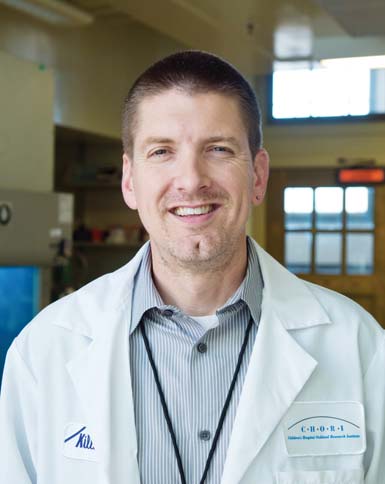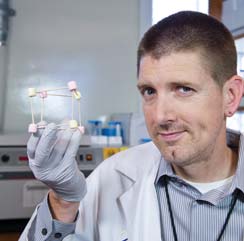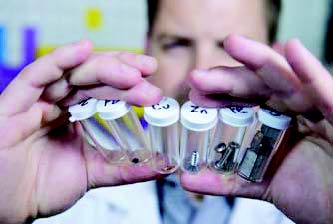Scientist Goes Back to School – To Teach 5th Graders
June 2014
As a child growing up in Mobile, Alabama, David Killilea, PhD, was fascinated by science. Now a Staff Scientist at Children’s Hospital Oakland Research Institute (CHORI), Dr. Killilea has been sharing his passion for science with local children since 2006 as a volunteer with Bay Area Scientists in Schools.
Article was originally published in Children’s Handprints, a publication of UCSF Benioff Children’s Hospital Oakland Spring 2014. Full article can be found here.

As a child growing up in Mobile, Alabama,
David Killilea, PhD, was fascinated by science. Now a Staff Scientist at Children’s Hospital Oakland Research Institute (CHORI), Dr. Killilea has been sharing his passion for science with local children since 2006 as a volunteer with the
Bay Area Scientists in Schools (BASIS) program sponsored by the local nonprofit organization Community Resources for Science (CRS). BASIS volunteers provide hands-on activities and science instruction in the Oakland Unified School District and the Berkeley Unified School Districts.
“I was inspired to become a scientist in early childhood because I had teachers in elementary school who actually engaged us with real experiments that made science come alive,” Dr. Killilea explains. “My own experience is what made me decide to volunteer with the BASIS program, to help instill a love of science in other children.”
After graduating with a bachelor of science degree in molecular biology at Rhodes College in Memphis, Tenn., he went straight into the PhD program in pharmacology at the University of Alabama in Mobile.
“The pharmacology program had a significant overlap with biochemistry, and then I became interested in the field of nutrition,” Dr. Killilea recalls. “I decided to come to CHORI in 2000 for post-doctoral work in nutritional minerals.”

Dr. Killilea worked under renowned CHORI Senior Scientist Bruce Ames, PhD, who serves as director of CHORI’s Nutrition & Metabolism Center and is professor emeritus of Biochemistry and Molecular Biology at the University of California, Berkeley. Dr. Killilea credits Dr. Ames with helping him “to understand the ‘big picture’ of nutritional science.” He credits CHORI Senior Staff Research Associate Sandra Larkin, MS, with introducing him to the BASIS program.
“I volunteered for BASIS because I had been looking forward to teaching,” Dr. Killilea notes. “BASIS offered me an opportunity to teach that didn’t interfere with my heavy load of research work at CHORI. BASIS is a fantastic program, and it is very flexible. You can volunteer to teach as many—or as few—classes as you want. I teach about 8 to 10 classes a year, but I would teach more frequently if I had the time.”
CRS was founded in 1997 in response to the need for improving science education in local schools. A survey of 923 Bay Area elementary school teachers reported that about 80 percent of those teachers spent less than an hour each week teaching science, including 16 percent who spent no time at all on science. Teachers noted they often lack the time or professional preparation for teaching science. In addition to the BASIS volunteer program, CRS offers workshops and science resource field trips for teachers and other programs to enhance teachers’ science teaching practices.
“The BASIS program works with the volunteers, providing us with the California Science Standards for kindergarten up to 7th grade,” says Dr. Killilea. “I decided to work with 5th grade, which has the educational objective of learning the elements of the periodic table. I felt I had a good background for teaching the elements and then transition to a discussion of nutrition. My presentation is called ‘
Elements of Life,’ and I tie it into real-world applications of the elements.

“When I learned about the periodic table of elements in middle school, basically all we did was memorize it,” he adds. “Kids need to know about how those elements fit into everyday life—such as how different elements combine to form compounds, and how minerals and gases are part of our bodies. So I designed tactile, hands-on experiments that make it fun and interesting for them. There’s nothing like the look on kids’ faces when they are involved and excited. That’s the reward for me—seeing them have that ‘Oh, wow!’ feeling.”
“I bring in small bottles containing real zinc, iron, copper, calcium, and other minerals that are part of the body,” says Dr. Killilea. Each bottle contains the exact amount of that element found in a child’s body. “They are really surprised by the amounts of these minerals, and it serves as a very visceral connection to why a good diet is important, to get enough nutrients like these minerals into our bodies. I also show them minerals that can be bad for you, such as lead, if you have too much of them in your body. “
Dr. Killilea notes that, in addition to taking part in the hands-on experiments, the students also pepper him with questions.
“I get lots of funny questions, such as what the element krypton has to do with Superman’s home planet,” he says. “But I also get health-related questions, such as how iron becomes toxic for people with sickle cell anemia and how calcium leads to bone formation. They also ask what I do as a scientist and how they can become a scientist. I really hope that my efforts will help inspire kids to pursue more science education and possible careers in science.”
Article was originally published in Children’s Handprints, a publication of UCSF Benioff Children’s Hospital Oakland Spring 2014. Full article can be found here.


 “When I learned about the periodic table of elements in middle school, basically all we did was memorize it,” he adds. “Kids need to know about how those elements fit into everyday life—such as how different elements combine to form compounds, and how minerals and gases are part of our bodies. So I designed tactile, hands-on experiments that make it fun and interesting for them. There’s nothing like the look on kids’ faces when they are involved and excited. That’s the reward for me—seeing them have that ‘Oh, wow!’ feeling.”
“When I learned about the periodic table of elements in middle school, basically all we did was memorize it,” he adds. “Kids need to know about how those elements fit into everyday life—such as how different elements combine to form compounds, and how minerals and gases are part of our bodies. So I designed tactile, hands-on experiments that make it fun and interesting for them. There’s nothing like the look on kids’ faces when they are involved and excited. That’s the reward for me—seeing them have that ‘Oh, wow!’ feeling.”